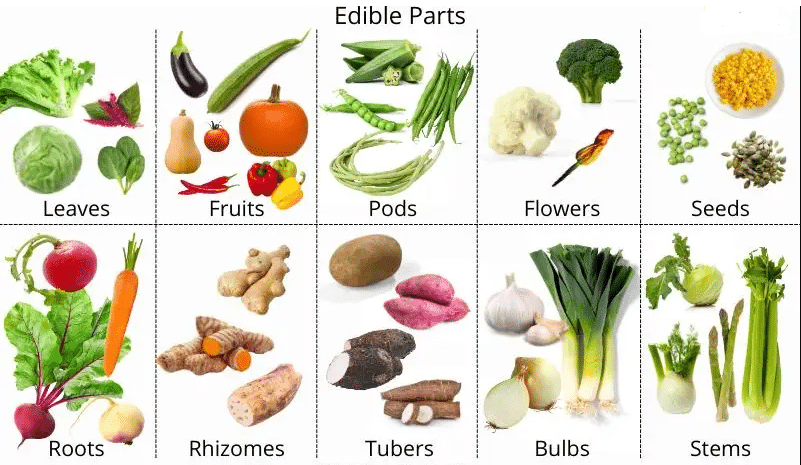Plants | General Knowledge Olympiad for Class 1 PDF Download
Plants are one of the important parts of nature. Plants are very useful for us as they give us many things like food, wood, paper, herbs, etc. The food we eat, primarily comes from plants such as vegetables, fruits, cereals, pulses, etc. A plant has various parts like roots, stems, flowers, leaves and fruits. Each part of the plant has different functions.
Parts of a Plant
1. Root
- It grows below the soil surface.
- It holds the plant firmly in its place.
- It provides support to the plant and stores food.
2. Stem
- It is green or brown in colour.
- It provides support to the whole upper part of the plant.
- It carries water and other minerals from roots to other parts of the plant.
3. Leaf
- It is the green structure of the plant prepares food for the plant.
- It is attached to the stem/ branch.
- Leaves of different plants have different shape, size, and colour.
4. Flower
- It is the most attractive and colourful part of the plant.
- Flowers of different plants have different shape, size, and colour.
- It changes into fruit.
5. Fruit
- It is the fleshy and ripened part of the plant.
- It encloses seed or seeds.
Types of Plants
- Herbs: These plants are small in size and have a soft stem. For example, carrot, radish, coriander, ginger, spinach, mint, etc.
- Shrubs: These are small and bushy plants with hard stem and branches. For example, rose, tulsi, hibiscus, cotton, etc.
- Trees: Trees are big, tall and strong plants. For example, mango, neem, banyan, coconut tree, etc.
- Climbers: These are weak plants and they need help of another plant or support to grow upright. For example, grapevine, money plant, pea, Beans, etc.
- Creepers: T hese plants grow along the soil. For example, pumpkin, watermelon, muskmelon, gourd, etc.
- Water Plants (Aquatic Plants): Water plants grow in water. For example, lotus, water lily, etc.
- Medicinal Plants: Some plants are used to prepare medicines, for example, tulsi, aloevera, neem, etc.
Edible Parts of Plants

Taking Care of Plants
- Plant more and more trees.
- Water them regularly.
- Add manure to the soil regularly.
- Don’t step on small plants and flower beds.
- Don’t cut down trees or plants.
The document Plants | General Knowledge Olympiad for Class 1 is a part of the Class 1 Course General Knowledge Olympiad for Class 1.
All you need of Class 1 at this link: Class 1
|
10 videos|51 docs|43 tests
|
FAQs on Plants - General Knowledge Olympiad for Class 1
| 1. What are the different parts of a plant and their functions? |  |
Ans. The different parts of a plant and their functions are as follows:
- Roots: They absorb water and nutrients from the soil and provide support to the plant.
- Stem: It provides support to the plant and transports water, nutrients, and sugars between the roots and leaves.
- Leaves: They are responsible for photosynthesis, where sunlight is converted into energy for the plant.
- Flowers: They are the reproductive organs of the plant and attract pollinators for fertilization.
- Fruits: They develop from fertilized flowers and contain seeds for the reproduction of the plant.
| 2. How does photosynthesis occur in plants? |  |
Ans. Photosynthesis is the process by which plants convert sunlight, carbon dioxide, and water into glucose (sugar) and oxygen. It occurs in the chloroplasts of plant cells, specifically in the chlorophyll pigment. The steps involved in photosynthesis are:
1. Absorption of sunlight by chlorophyll in the leaves.
2. Conversion of light energy into chemical energy.
3. Splitting of water molecules into hydrogen and oxygen.
4. Utilization of the hydrogen from water to convert carbon dioxide into glucose.
5. Release of oxygen as a by-product.
| 3. What is the importance of plants in the ecosystem? |  |
Ans. Plants play a crucial role in the ecosystem due to the following reasons:
- Oxygen production: Plants release oxygen through photosynthesis, which is essential for the survival of all living organisms.
- Food source: Plants are the primary producers in the food chain, providing nutrition to both animals and humans.
- Carbon dioxide absorption: Plants absorb carbon dioxide, a greenhouse gas responsible for climate change, and help regulate the Earth's temperature.
- Habitat and shelter: Plants provide habitats and shelters for various animals, birds, and insects.
- Soil erosion prevention: Plant roots hold the soil together, preventing erosion and maintaining the fertility of the land.
| 4. How do plants reproduce? |  |
Ans. Plants reproduce through two main methods: sexual reproduction and asexual reproduction.
- Sexual reproduction: In this process, plants produce flowers, which contain male and female reproductive organs. Pollination occurs when pollen from the male organ (stamen) reaches the female organ (pistil), leading to fertilization and the production of seeds.
- Asexual reproduction: Plants can also reproduce asexually through methods such as vegetative propagation and budding. In vegetative propagation, new plants are formed from stems, roots, or leaves of the parent plant, while budding involves the growth of a new plant from a bud on the parent plant.
| 5. How do plants adapt to different environments? |  |
Ans. Plants have various adaptations that allow them to thrive in different environments. Some examples include:
- Desert plants have deep root systems to access water underground and thick waxy leaves to reduce water loss.
- Aquatic plants have air-filled tissues to float and obtain oxygen from the water.
- Plants in cold regions have hairy leaves to trap heat and protect themselves from freezing temperatures.
- Rainforest plants have large leaves to capture maximum sunlight in the dense canopy.
- Alpine plants have a short and compact growth form to withstand strong winds and cold temperatures.
Related Searches
















